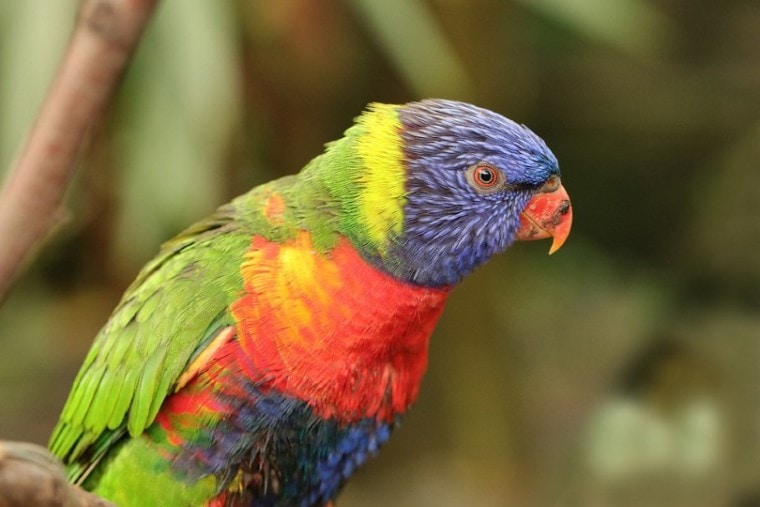
If you’re looking to adopt a bird and want one with beautiful plumage, the Lorikeet likely comes to mind. Lorikeets are incredibly colorful birds that can make great but challenging pets for various reasons.
So, how do you know if a Lorikeet is right for your home? We break it all down for you here, so you have a better idea of what to expect before you head out and purchase a bird.
Lorikeet Background/History

Technically grouped into six different subspecies, the Lorikeet is a medium-sized parrot originally found in Australia and New Guinea. Today, you can find these birds in those locations, but they’ve also migrated to Tasmania, New Zealand, and Hong Kong.
Lorikeets are all extremely colorful and they can come in various sizes. In the wild, they can travel up to 40 miles per day, and they’re typically extremely vocal. These characteristics can make them a bit more challenging to own as a pet.
Pros of Owning a Lorikeet
While most people start looking at the Lorikeet because of their extremely colorful plumage, it’s everything else that they have to offer that convinces people to purchase one. They’re extremely smart birds, and if you get a larger Lorikeet, they’re outstanding talkers.
They are smart and extremely trainable and their personality really shines through. They love to entertain and be the center of attention, but they’re also extremely affectionate and curious. They do their best to make jokes and play all the time. Not only will they vie for your attention, but they’ll also spend a decent amount of time entertaining themselves as long as you give them plenty of toys.
These are beautiful and playful birds, so if you have the attention and time to give to them, they can be an extremely rewarding pet.
Cons of Owning a Lorikeet

While you can’t consider any bird easy to own, the Lorikeet is even more challenging than most. They need tons of activity in the wild to stay healthy, which means they need tons of exercise as pets. They require multiple hours outside of their enclosure each day and extremely large cages that they can fly around in when you aren’t giving them attention.
However, their exercise requirements are only part of what makes them difficult to own. Another huge challenge is their diet. They require both pollen and nectar as staples in their diet, and this isn’t the easiest thing to keep up with. Moreover, these two foods lead to droppings that are far runnier than those of other birds. Runnier droppings lead to larger messes, and they’re a bit more challenging to contain and clean up.
Additionally, these birds can be extremely protective of their possessions, especially toward other birds. This makes it best to keep them as solitary birds, and you should be careful when removing toys to cycle them in and out.
Another big concern is the amount of noise that they can make. While this is especially a concern with larger Lorikeets, it’s something that you need to keep in mind no matter which size bird you choose. If you live somewhere close to other neighbors, the amount of noise that your Lorikeet makes can cause problems.
Finally, you’ll need to give these birds daily baths and showers, which means even more time out of your day to care for them. Before adopting a Lorikeet, you need to ensure that you have 4–5 hours every day to devote to them. Otherwise, you’re asking for problems that you won’t have the time to take care of.
Picking a Lorikeet

While there are six different Lorikeet subspecies, the biggest factor in picking out your Lorikeet has to be their size. For starters, small Lorikeets can’t talk or mimic. This can make them a bit boring for some owners, but it also means they’re quiet. While they still aren’t ideal for apartment living, you won’t hear their noises that often.
Moreover, smaller Lorikeets are a bit easier to care for than larger Lorikeets. They don’t need quite as much space, though you shouldn’t give them too small of an enclosure. However, while smaller Lorikeets are easier to care for, they aren’t always as fun. Not only do larger Lorikeets talk more and mimic speech, but they’re also a bit more intelligent and curious. This makes them far more trainable, but you will need to spend extra time with them. Their intelligence and curiosity can be a joy to work with, though it means you need to keep up with their obedience training, or you’ll run into behavioral problems.
While we’d like to recommend sticking with a small Lorikeet until you have a bit more experience, considering that these birds can live anywhere from 20 to 30 years, that’s not always the best idea.
Final Thoughts
No bird is easy to own, and the Lorikeet is a bit more challenging than most. However, if you’re looking for an outstanding companion, the Lorikeet makes a great choice. The key is to spend enough time with them.
So, if you have plenty of extra time and want a companion to spend your days with, a Lorikeet might be exactly what your life has been missing.
Related Reads:
Featured Image Credit: MarjonBesteman, Pixabay









